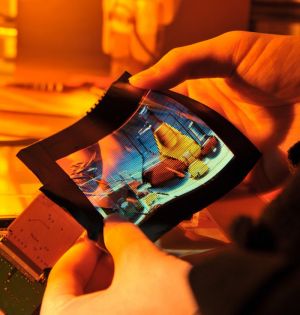OLED (Organic Light Emitting Diodes) is a flat light emitting technology, made by placing a series of organic thin films between two conductors. When electrical current is applied, a bright light is emitted. OLEDs can be used to make displays and lighting. Because OLEDs emit light they do not require a backlight and so are thinner and more efficient than LCD displays(which do require a white backlight).
OLED vs LCD
OLED displays have the following advantages over LCD displays:
- Lower power consumption
- Faster refresh rate and better contrast
- Greater brightness - The screens are brighter, and have a fuller viewing angle
- Exciting displays - new types of displays, that we do not have today, like ultra-thin, flexible or transparent displays
- Better durability - OLEDs are very durable and can operate in a broader temperature range
- Lighter weight - the screen can be made very thin, and can even be 'printed' on flexible surfaces

The future - flexible and transparent OLED displays
It turns out that because OLEDs are thin and simple - they can be used to create flexible and even transparent displays. This is pretty exciting as it opens up a whole world of possibilities:
- Curved OLED displays, placed on non-flat surfaces
- Wearable OLEDs
- Transparent OLEDs embedded in windows
- OLEDs in car windshields
- New designs for lamps
- And many more we cannot even imagine today...
Several companies are working towards such displays. In fact TDK is already producing simple transparent OLEDs, and Lenovo's S-800 phone is the first product to use them.
How do OLEDs work?
An OLED is made by placing a series of organic thin films between two conductors. When electrical current is applied, a bright light is emitted.
Click here for a more detailed view of the OLED technology
So what's organic about OLEDs?
OLEDs are organic because they are made from carbon and hydrogen. There's no connection to organic food or farming - although OLEDs are very efficient and do not contain any bad metals - so it's a real green technology.
Where can I find OLED displays today?
Samsung is the clear leader in both production and adoption of OLEDs. Samsung is using OLED panels in all of their flagship devices, including the Galaxy S4 and the Galaxy Note 3. OLEDs are also used in digital cameras, car audio systems, A/V players and other mobile devices. In the past years we've seen many companies adopting OLEDs in their devices, including Samsung, Sony, Nokia, LG, Dell, Olympus, HTC, ASUS, Panasonic, Microsoft and others.
OLEDs are used in mobile devices today because they are thin, efficient and bright. Obviously OLEDs carry a price premium over LCDs, but companies are using these displays more and more. Here's our list of products and gadgets with an OLED display.
OLED TVs
In January 2013, LG launched the world's first OLED TV, the 55EM9700. LG's TV features a stunning 55" Full-HD panel that offers superb colors and contrast ratio. The TV is only 4 mm thick and weighs just 3.5 Kg.
Both LG and Samsung are also offering curved OLED TV. Samsung's KN55S9C for examplecosts $8,997 while LG's 55EA9800 is even more expensive at $9,999. Both panels are 55" in size and offer Full-HD resolution. Reviews of those TVs have been spectacular, with all reviewers saying that OLED TVs offer the best picture quality ever.
OLED disadvantages
OLEDs aren't perfect. First of all, today it costs more to produce an OLED than it does to produce an LCD - although this should hopefully change in the future, as OLEDs has a potential to be even cheaper than LCDs because of their simple design.
OLEDs have limited lifetime (like any display, really), that was quite a problem a few years ago. But there has been constant progress, and today this is almost a non-issue. Today OLEDs last long enough to be used in mobile devices and TVs. OLEDs can also be problematic in direct sunlight, because of their emmissive nature. But companies are working to make it better, and newer AMOLEDs (such as Samsung's Super AMOLED andSuper AMOLED Plus and Nokia's CBD displays) are quite good in that respect - some even consider them superior to LCDs.

Can OLEDs produce white lighting?
Yes, OLEDs actually make for a great light source. OLEDs offer diffuse area lighting and can be flexible, efficient, light, thin, transparent, color-tunable and more. OLEDs will probably be used in completely new lighting designs.
www.skylcd.com

